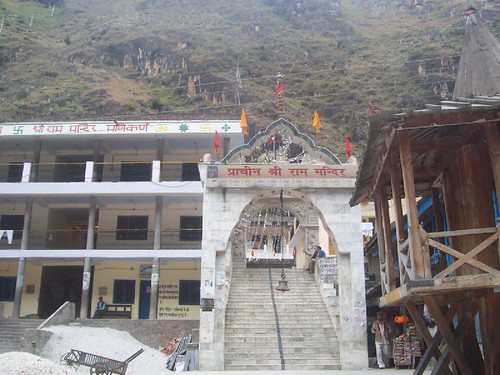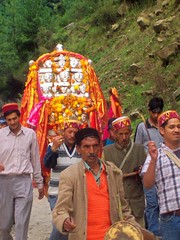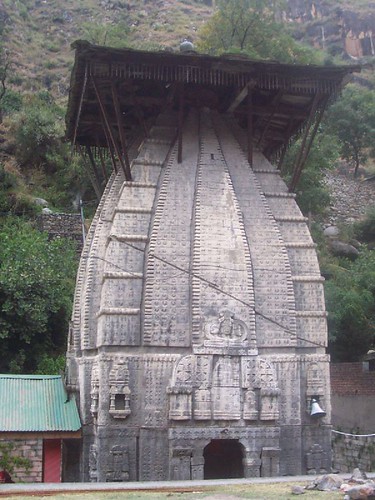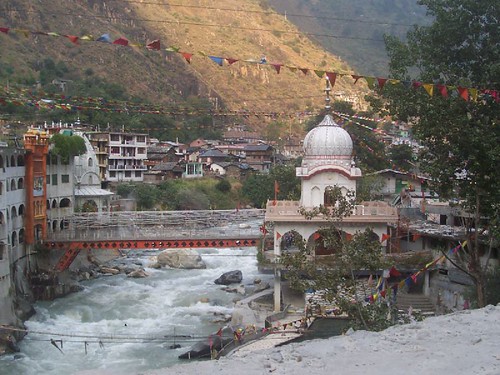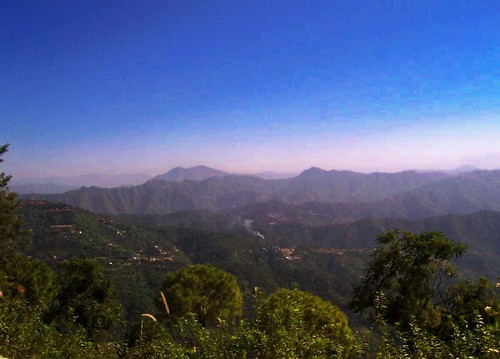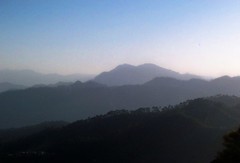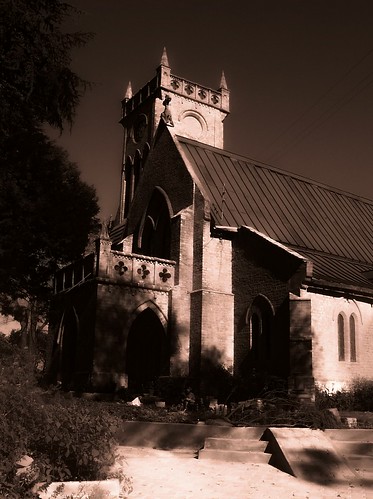State: HIMACHAL PRADESH
Location: Manikaran(545km from Delhi, 245kms from Shimla, 86kms from Manali)
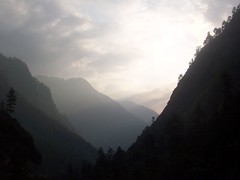 The journey to Manikaran is a unique one. After tavelling parallel to the river Bias on the Shimla-Manali highway the road to Manikaran takes a sudden right turn crossing the river and goes uphill. Apparently the road is like any other hilly road, high rocky mountain on the right and a steep cliff falling for miles into the crushing river that flows turbulently below! The scary part is that the road is very narrow and there is no fence on the side of the cliff and adding to your woes, the road is unmettled and just when you thought you can somehow maneuver your car uphill, you see a Himachal Pradesh State Tourism omni bus at the bend and heading towards you in full steam! This road is a perfect amalgamation of danger and beauty as often you will find yourself traveling with the river on one side and deodar forest on the other and in the next instant you find yourself thousands of feet above the river and huge chunks of bare rocks hanging ominously over you.
The journey to Manikaran is a unique one. After tavelling parallel to the river Bias on the Shimla-Manali highway the road to Manikaran takes a sudden right turn crossing the river and goes uphill. Apparently the road is like any other hilly road, high rocky mountain on the right and a steep cliff falling for miles into the crushing river that flows turbulently below! The scary part is that the road is very narrow and there is no fence on the side of the cliff and adding to your woes, the road is unmettled and just when you thought you can somehow maneuver your car uphill, you see a Himachal Pradesh State Tourism omni bus at the bend and heading towards you in full steam! This road is a perfect amalgamation of danger and beauty as often you will find yourself traveling with the river on one side and deodar forest on the other and in the next instant you find yourself thousands of feet above the river and huge chunks of bare rocks hanging ominously over you.
Distances from Manikaran
The City of Manikaran
Once you reach Manikaran you are sure to be blown away by the sheer natural beauty of the place. The small hill town on Manikaran is surrounded by mountains on all side and right through it flows the turbulent Parvati river and the sound of the gushing water reverberating in the valley! Usually visitors reach the left bank of the river which is the tourist spot while the actual town of Manikaran is on the otherside of the river.
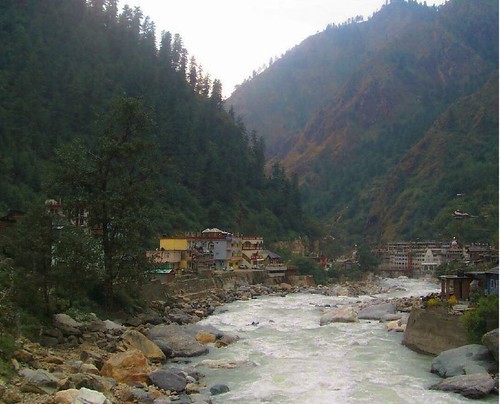
The river Parvati flowing through Manikaran
 It is a picturesque town on the slope of a very steep hill. Manikaran has got a very interesting history(if I may call it) about its origin...
It is a picturesque town on the slope of a very steep hill. Manikaran has got a very interesting history(if I may call it) about its origin...
THE LEGEND OF MANIKARAN:
While wandering in the forests of the Himalayan ranges Lord Shiva and Goddess Parvati came across a place now called Manikaran. The mountain-locked area, the lush green patches and the forests charmed them and they decided to stay there for sometime.For as long as eleven hundred years they remained at this place. At one time, when the Lord was relaxing with the Goddess, in the beautiful waters of a stream running by the side, the 'MANI' (Precious stone) in an earring of the goddess dropped somewhere.Parvati was much distressed and there was a thorough search but efforts to find out the precious stone failed. Lastly, the Lord ordered his attendants, to trace out the jewel, wherever it may be. That was also unsuccessful. Lord Shiva got enraged, as a result of which his third eye opened. With the opening of the third eye of the Lord Shiva, a very ominous event, there was a great commotion all over the universe. The entire universe was very upset and apprehended a great calamity.'Shesh Nag', the serpent god, was approached. In order to subside the anger of Lord Shiva, Shesh Nag hissed and hissed and there was a flow of boiling water, which passed over the area and out came a number of precious stones of the type which were lost. Lord Shiva was pacified. The water still continues to be hot. Before the earthquake of 1905, which affected this area, it is said, that this boiling water used to rise, to about ten-feet high.The visiting deities are given a ceremonial bath. The second chapter of 'Brahm Puran' recites the story of Manikaran as given above. The place is described as one of hot and cold waters and the divine pair had repaired there for water sports known as 'Jal-Krida'. Fragrant and attractive flowers graced the place and by a bath at the 'Sangam' one is eternally blessed. The Brahm-Puran enjoins the pilgrims pass a night awake at Manikaran and do puja or 'Raat-Jagran'.Thereby the pilgrims obtain the full virtue of the world. The story of the loss of the precious stone and the frantic search and ultimate recovery is vividly described. The tract is Lord Shiva's own and a pilgrimage at this place is adequate and one need not visit Kashi and other places of pilgrimage.
Hotels and accommodation:
There are a plenty of Hotels and accommodations on the left bank of the river. During off seasons a double bed room can cost you as low as Rs. 300/-(INR). But make one thing pretty sure before you check into a hotel! No matter how awesome looking the hotel maybe or no matter how cheap room tariffs they may offer…if they do not provide you with the Hot spring water (main attraction of Manikaran) within your hotel(either in bathroom taps or in a common swimming pool/tank) do not move in! try checking out some other hotel, your sure to find one.
Places of Interest:
Lord Ramchandra Temple: There are several temples in the Mani Karan village. The most important is that of Lord Ramchandra. The Pandas or priests of the village claim that the idol of Rama was brought from Ayodhya and installed in this temple by the Raja of Kulu but this lacks a historic confirmation. There was also an idol of Lakshman the younger brother of Lord Rama Chandra, which has now disappeared. On the left hand side of the Lord is the idol of Goddess Sita. The temple is very old and on one of the stones in its wall, the history of the temple is written which is not legible.
Ramachandra temple
Dasera in Manikaran
Temple of Lord Shiva: There is another very old temple of Lord Shiva, which got tilted during the earthquake of 1905. The great prestige with which Manikaran is held is seen by the fact that the Devatas of Kulu valley pay regular visits to Manikaran. The followers of the individual deities at different places are carried ceremoniously in a procession to Manikaran on specified auspicious days.
The Shiv Mandir
Sri Guru Nanak Dev Ji Gurudwara: The place is also held sacred by the Sikhs. The Janam Sakhi or the 'Twarikh Guru Khalsa' by Giani Gian Singh mentions about the visit of Guru Nanak Dev to this place. It has been mentioned that accompanied by his disciple Bhai Mardana, the Guru reached Jwalamukhi temple after visiting Kalanaur, Gurdaspur, Dasuya, Triloknath, Palampur and Kangra. The Guru then proceeded towards Mandi and after visiting Chamba and Kulu, he came to Bijli Mahadev. After preaching at all these places Guru Nanak Dev came to Mani Karan. The Janam Sakhi or the "Autobiography of Bhai Mardana" mentions the miracles did by the Guru. The Guru came to Mani Karan along with his Five 'Piaras' or followers.
The Gurudwara at Manikaran.
Hot Springs: By taking bath here and by drinking water of this place, people go to Heaven, this is said of the Manikaran tract since the times immemorial. It is just like 'Kashi Kshetra' and there is no doubt about it. On examination it is understood that the Manikaran hot spring is said to have got Uranium and other radio active minerals.
Harinder Mountain & Parvati River: On the northern side, there is a mountain, which is named as Harinder. Merely a look at this mountain will make a person free from all evils and on the south is the Parvati River.
Kulant Pith: Out of all sectors 'Piths' of the country, this sector, which is called 'Kulant Pith', is the superior most. Here, the most sacred place of pilgrimage is Manikaran, and in it the 'Vishnu Kund' is the purest of all. Lord Shankara was mightily pleased to stay here and this is absolutely true. No other tank in the world, could be more pure than these high rising tanks. Even a drop of water from the tanks will make one free of all evils. Narad, on account of the influence of the Shankara's eye, said that this sacred place, causes the disappearance of anger and evils. One who eats the food cooked in this boiling water goes to the Vishnu Lok.
Looking Forward to your comments...
_____X____X____X___X____X____X____X____X____X____X____X

